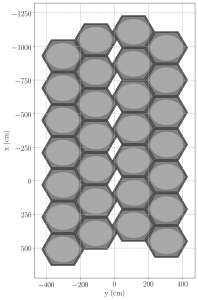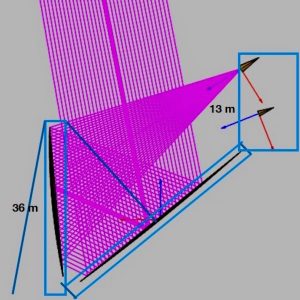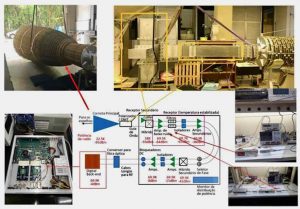The main motivation of the BINGO radio telescope is to be the first telescope to detect BAO in the radio band of the electromagnetic spectrum, more specifically between 980 MHz and 1260 MHz. Through measurements of the 21 cm line, maps of the HI distribution will be created in different frequencies intervals, which will provide data for the detection of BAO, contributions to the restriction of cosmological parameters and a greater understanding of dark energy.
BINGO is an international collaboration led by the University of São Paulo, with the main participation of INPE, and the Federal University of Campina Grande (PB), in Brazil; Yangzhou University (China) and University of Manchester (England). The other collaborating institutions are: Shanghai Jiao Tong (China), University College London (England), Institute for Basic Science (South Korea), IAP – Institut d’Astrophysique de Paris (France), University of Rome (Italy), IAC – Instituto de Astrofísica de Canarias (Spain), Technische Universität München (Germany), Max Planck Institute (Germany), University of KwaZulu-Natal (South Africa), ETH Zurich (Switzerland), Federal University of Itajuba (Brazil), Federal University of Cariri (Brazil), Baylor University (US), University of Texas at Austin (US), and University of Texas at Dallas (US).
The instrument will be installed in Serra da Catarina, at the city of Aguiar, in the Piancó Valley, which is located at the outback of the State of Paraíba, (Lat: 07º02’57” S, Long: 38º15’46” W, see the map below), where the levels of radio interference (or RFI) in the radio telescope’s operating band were the lowest found during the RFI measurement campaign. Such a campaign was carried out in 2016 – 2017.
A summary of the optical system and features of BINGO can be found in the table below:
|
Primary reflector |
Off-axis paraboloid, 40 m in diameter |
|
Secondary reflector |
Off-axis hyperboloid, 36 m in diameter |
|
Effective focal length |
63.2 m |
|
FWHM |
0.67 ° (40 ‘) |
|
Number of horns |
28 (circular polarization) |
|
Horn opening |
1.9 m |
|
Horn length |
4.3 m |
|
Covered area in the sky |
~ 5300 deg² |
|
System Temperature |
70 K (non-cryogenic) |
|
Frequency band |
980 – 1260 MHz |
|
Redshift interval |
0.13 – 0.45 |
|
Channel resolution for FFT |
Undefined |
BINGO will make observations in the frequency range between 980 MHz and 1260 MHz. The lower cut in frequency (980 MHz) is to minimize the RFI, reducing the interference of cell phone signals (between 700-956 MHz).
The BINGO radio telescope privileges a concept that is complementary to interferometric radio telescopes: it will use, for the same reflector system, many detectors in the focal plane. In general, interferometers are made up of many reflectors and only one detector (or few) in the focal plane. Telescopes like BINGO have a clear advantage in the cost of manufacturing and maintenance, in addition to the fact that data processing is inherently simpler. The obvious disadvantage is that the collecting area of an interferometer will normally be much larger than that of a single telescope, and the consequent angular resolution, much better. A schematic diagram of the telescope, with a hexagonal arrangement of the horns and the optical system, appears in Figure 1. The orientation of the focal plane in relation to the sky and the local coordinates is shown in Figure 2.


The construction of prototypes and testing of horns, as well as the radio telescope electronics, development, and testing of calibration and data reduction techniques, have been done by INPE – Brazil. The majority of BINGO’s components are produced/manufactured by the Brazillian national industry.
Figure 3 shows the BINGO receiver + horn scheme, with the block diagram in the center. The digital backend (red rectangle at the bottom left of the block diagram) will perform the fast Fourier transform (FFT) of the signal sent by the receiver chain, separating them into different channels between 980 and 1260 MHz. This number will still be defined.

